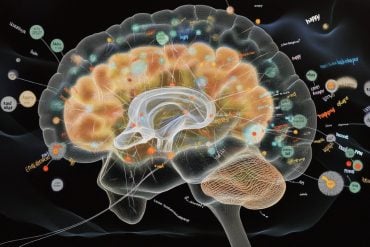A new study concludes that parental depression contributes to greater brain activity in areas linked to risk taking in adolescent children, likely leading to more risk-taking and rule-breaking behaviors. While previous research has found associations between clinically depressed parents and their teenagers’ risk taking, the new study is the first to find corresponding changes in the adolescents’ brains.
The study is reported in the journal Social Cognitive and Affective Neuroscience.
“This is the first empirical evidence to show that parental depression influences children’s behavior through the change in the adolescent’s brain,” said University of Illinois graduate student Yang Qu, who led the study with U. of I. psychology professor Eva Telzer.
“There are a lot of changes happening in the teen years, especially when we are thinking about risk-taking behaviors,” Telzer said.

The researchers followed a group of 23 adolescents, 15 to 17 years old, with cognitive testing and brain imaging at the beginning and end of the 18-month study. Using functional magnetic resonance imaging, the researchers measured changes in blood oxygen levels in the brain while the study subjects clicked a button to inflate a computerized balloon. The goal was to inflate the balloon as much as possible without popping it. More clicks earned the teens a greater monetary reward, but if it popped, they earned nothing.
“The more risky they are in real life, the more risky they are on the task as well,” Telzer said.
The researchers also collected information on the adolescents’ rule-breaking behaviors, such as sneaking out without parental permission, substance abuse and partying.
To measure parental depression, the team collected data from the parents on their own depressive symptoms, including feelings like “I couldn’t shake off the blues” and “Everything I did was an effort.” Telzer and Qu measured these symptoms in parents who were not currently being treated for clinical depression.
They found that adolescents whose parents had greater depressive symptoms increased their risk taking over the course of the study. The team also saw changes in how the teens’ brains responded to risk taking.
“At the neural level, they show increases over time in activation in the ventral striatum,” Telzer said. “The ventral striatum is a key brain region involved in risk taking, and it has also been linked in some studies to depression.”
These new findings help to explain the relationship between parental depression and an adolescent’s risky behaviors, Qu said.
“Even if you are not clinically depressed and seeking out help, your teen is probably picking up on the negative emotions that you may be experiencing,” Telzer said. This unconscious awareness can influence teens’ risk-taking behaviors and also shape the way their brains respond to risky situations.
Source: Sarah Banducci – University of Illinois
Image Source: The image is in the public domain.
Original Research: Abstract for “Links between parental depression and longitudinal changes in youths’ neural sensitivity to rewards” by Yang Qu, Andrew J. Fuligni, Adriana Galván, Matthew D. Lieberman, and Eva H. Telzer in Social Cognitive and Affective Neuroscience. Published online March 24 2016 doi:10.1093/scan/nsw035
Abstract
Links between parental depression and longitudinal changes in youths’ neural sensitivity to rewards
Parental depression is a significant risk factor for adolescents’ engagement in risk taking. Yet the neural processes that mediate the link between parental depression and adolescents’ functioning remain unknown. Using a longitudinal functional magnetic resonance imaging design, we investigated how parental depression is associated with changes in adolescents’ neural reactivity to rewards during a risk-taking task, and how such changes in neural reactivity are associated with changes in risk-taking behavior. Greater parental depressive symptoms were associated with increases in their adolescent child’s risk taking and self-reported externalizing behavior over time. At the neural level, adolescents of parents with greater depressive symptoms showed longitudinal increases in the ventral striatum and dorsolateral prefrontal cortex to rewards during risk taking. Longitudinal increases in adolescents’ ventral striatum activation mediates the link between greater parental depression and increases in adolescents’ risk taking and externalizing behavior. These findings provide novel evidence that parental depression may contribute to changes in adolescents’ neural reactivity to rewards over time, which is associated with greater increases in their risk taking and externalizing behavior.
“Links between parental depression and longitudinal changes in youths’ neural sensitivity to rewards” by Yang Qu, Andrew J. Fuligni, Adriana Galván, Matthew D. Lieberman, and Eva H. Telzer in Social Cognitive and Affective Neuroscience. Published online March 24 2016 doi:10.1093/scan/nsw035






